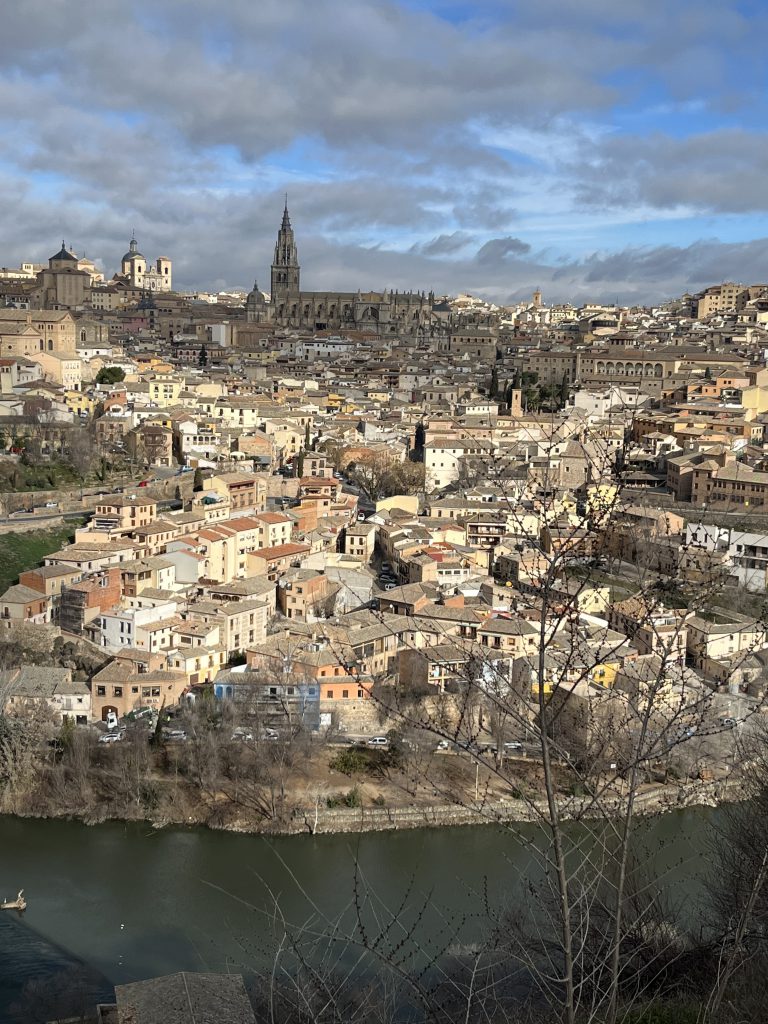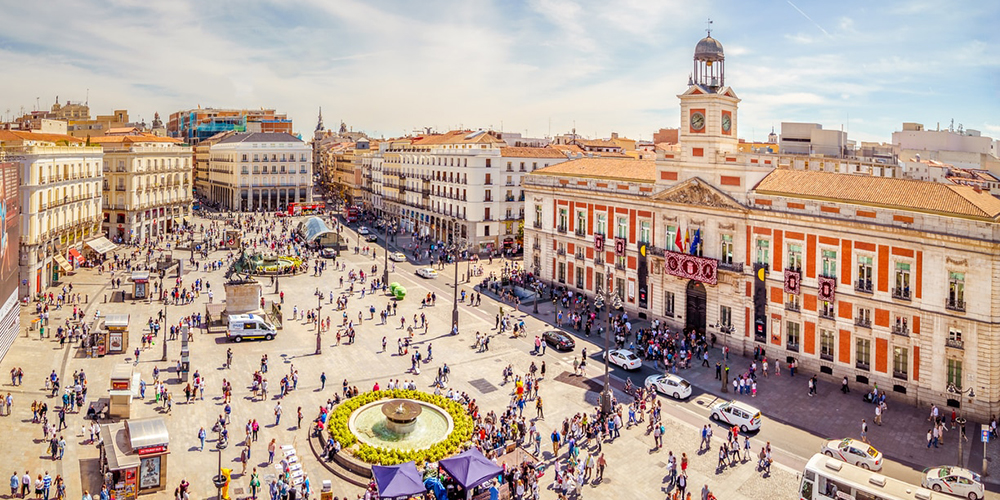Toledo is a beautiful and rustic city situated on a large hill above the plain of Castilla La Mancha in the heart of the country. Though originally founded by the Romans, the city was the former capital of Spain until 1561 when King Phillip II moved the royal court to Madrid instead. Toledo is an hour from Madrid, and the ride will have you pass through empty fields with a few ramshackle structures peppering the countryside. Large box stores or supply depots with garish colors are placed in small clusters adjacent to the highways. The drab surroundings quickly melt away when entering the city’s limits as the picturesque landscape, valleys, and houses catch one’s eye immediately.
The winding road to the top of the hill will have tourists look down upon the valley that has been etched by the Tagus, the longest river in the Iberian Peninsula. The river surrounds three sides of Toledo, making it appear like a large castle town surrounded by a moat. Puente de San Martin, which offers a beautiful view of the river below and the city above, is a truly stunning arch bridge which exudes rustic medieval charm. It was originally constructed in the thirteenth century, once open to carriages, and later cars, yet currently is only traversed by foot. This choice is perhaps for the better, as the magical views deserve thoughtful recognition from those who pass over it. Perhaps even more satisfying is to view the bridge from a distance, as its presence over the valley beneath paints a better scene.
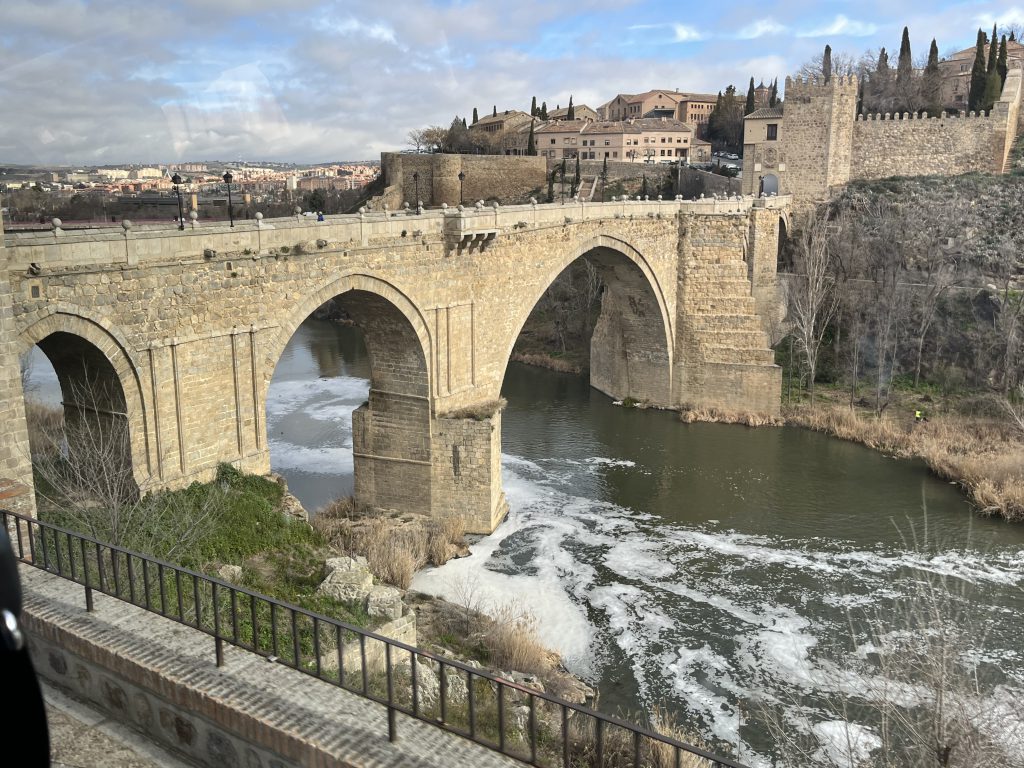
After this, following the winding paths up the hillside lead to the Monastery de San Juan de los Reyes. This structure was built to celebrate the victory of King Ferdinand of Aragon and Queen Isabella of Castile over Alfonso V. The Monastery was last restored in the 1960s following damage from Napoleon’s invasion in 1833. A key thing to note, any stones with shinier or clearer color signify where repairs were carried out. In spite of this, they look no less stunning than in the original forms. Various saints and angels adorn the exterior, namely Saint John the Evangelist, to whom the structure was dedicated. Chains on the outside of the structure represent freedom, as those chains once held prisoners that were released under the rule of Ferdinand and Isabella. The inside of the monastery boasts delightful cloisters surrounding an open-air garden, which alway contained pine trees and other such plants. Intricate eight-point star patterns adorn the ceilings of these areas, representing the Moors’ who constructed them. The impressive church houses incredibly ornate patterns etched into marble and limestone. Notably, eagles represent Saint John. The repeated symbols of yokes and bundles of arrows represent Ferdinand and Isabella respectively. Currently, the church houses a float which is being prepared for Easter, though its colorful quality juxtaposes the monotone interior of limestone.
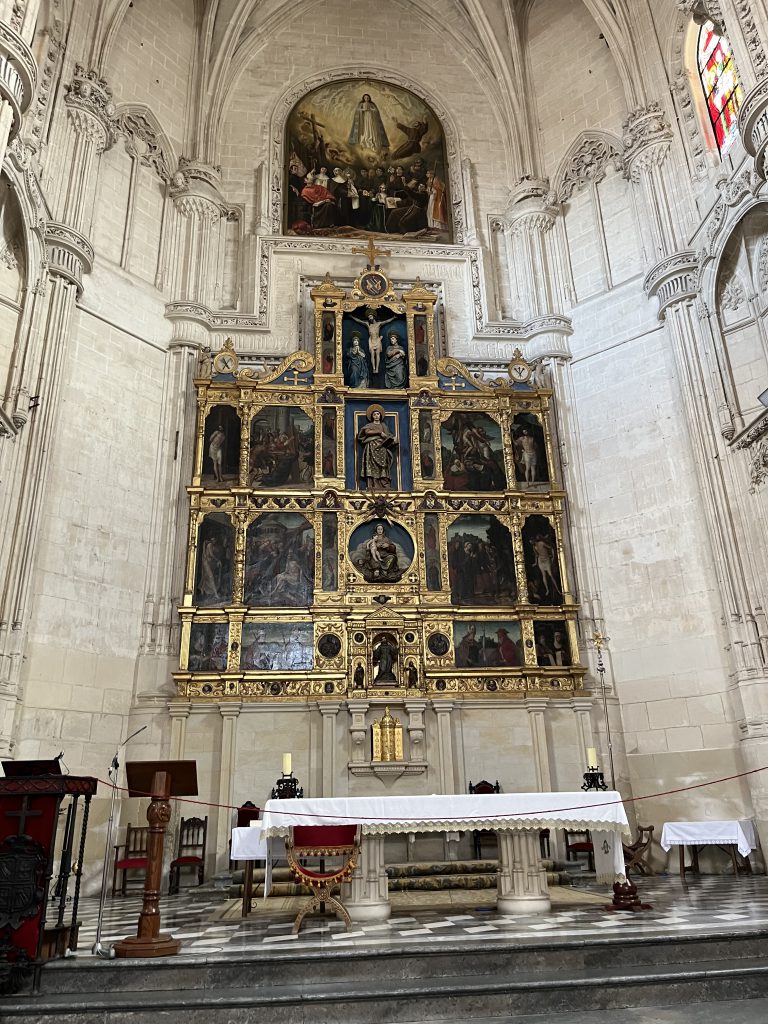
The monastery sits within the Jewish ‘Quarter’, which earned its name for the original population of Jewish people within the section of the city. While they were ousted some time ago when the area was purged of non-Catholics, the area pays homage to their previous occupation of the city with various tiles containing Hebrew words and symbols, which have been attached to walls and streets. It is interesting
Last, but not least, was a tour through the Toledo Cathedral. Having taken almost 300 years to complete, the large cathedral exhibits three architectural styles: Neoclassical, Gothic, and Plateresque. The inside of the church sports incredible stained glass and marble sculptures, ornately carved wooden seats, large pipe organs, and impressive frescoes that wrap seamlessly onto the curved ceilings. The sheer amount of detail one could pick out in this building demands multiple revisits, as there is simply too much to take in for one viewing. The church has several tombs of previous bishops lying under the ground, which are covered with large engraved plaques on the floor, and signified with the cardinal hats hanging from the ceiling. This proved to be somewhat unnerving, furthered by the fact that some tombs remain above ground. One cardinal was buried one year ago in the church’s main hall, and fresh bouquets line the plaque covering the burial spot. A notable treasure of the church, is the Monstrance of Arfe, a carrier for the host which represents the body of Christ. The piece is made of solid gold and silver, weighing in at over 400 pounds and measures in at over ten feet tall. It is used in the annual feast of Corpus Christi held in Toledo. A truly magnificent piece, it is perhaps more precious and awe-inspiring than the so-called ‘ark of the covenant’ from Indiana Jones. When not in use, the piece sits upon an equally as stunning base, featuring carved figures in place of standard table legs. The piece took seven years to complete, and is very much worth the admiration. It is rumored to be crafted of the first of the gold that Columbus brought back with him from South America, which caused some to wrinkle their noses at the piece, myself included.

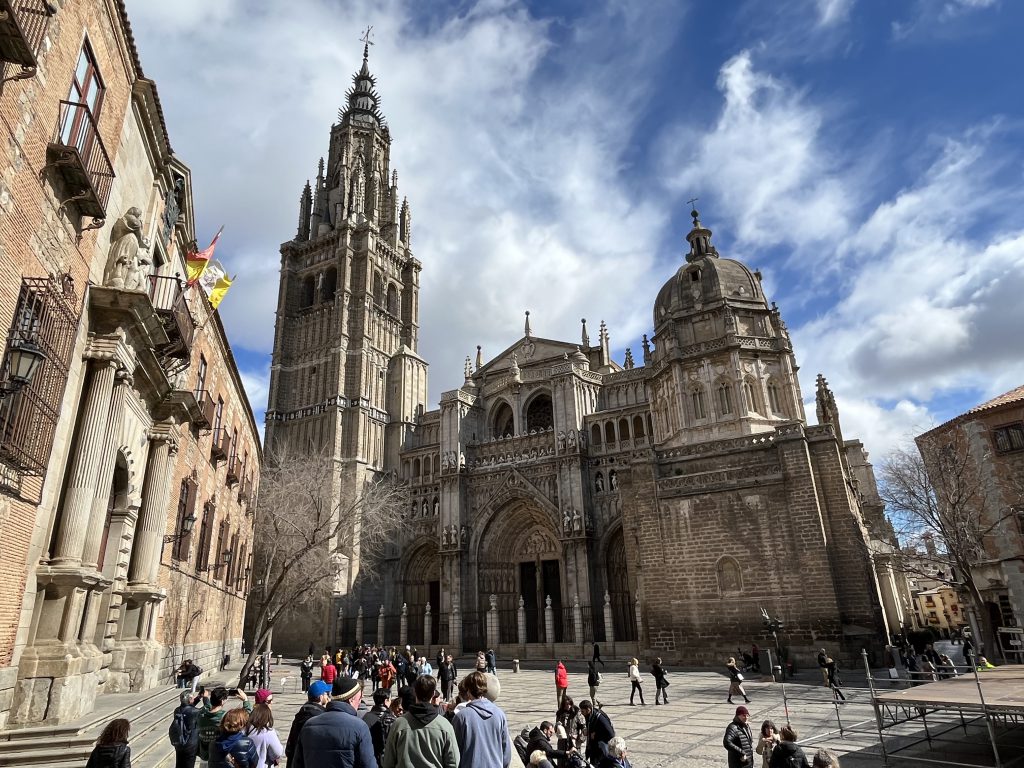
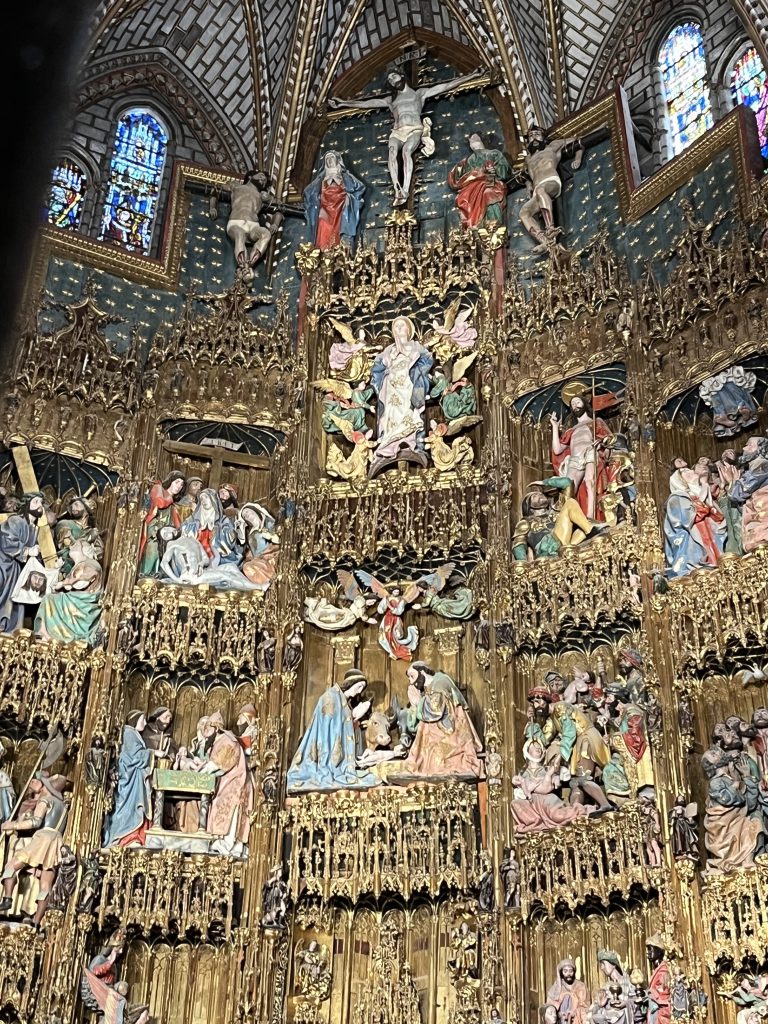
Right, Toledo’s Cathedral
Middle, Inner Altar
From the plaza, several narrow corridors and meandering streets bring about a sense of whimsy, each turn leading to something exciting and different. The city in itself contains many shops with stunning handmade jewelry, leather accessories, and medieval weaponry such as swords and knives. From the hillier parts of the section, one can see several of the large homes. Some of the most expensive and grand houses one may ever encounter, some were refurbished to become hotels while others remain residential. They are reminiscent of American ranches, but with far smaller plots of land surrounding them, more so full of orchards instead. Surrounding this area are rolling hills covered with vibrant greens of the grass and cyprus, almond, or olive trees. The foliage and colors of the landscape seem like a fairytale. Toledo is home to delicious marzipan, an almond paste mixed with honey and sugar, and olive oils. The pastries are definitely worth a try for those with a sweet tooth. A break for lunch led us to a local restaurant, which featured delicious tapas plates. In addition, there was an exquisite gazpacho, featuring the much more flavorful Spanish tomatoes which outclass American tomatoes.
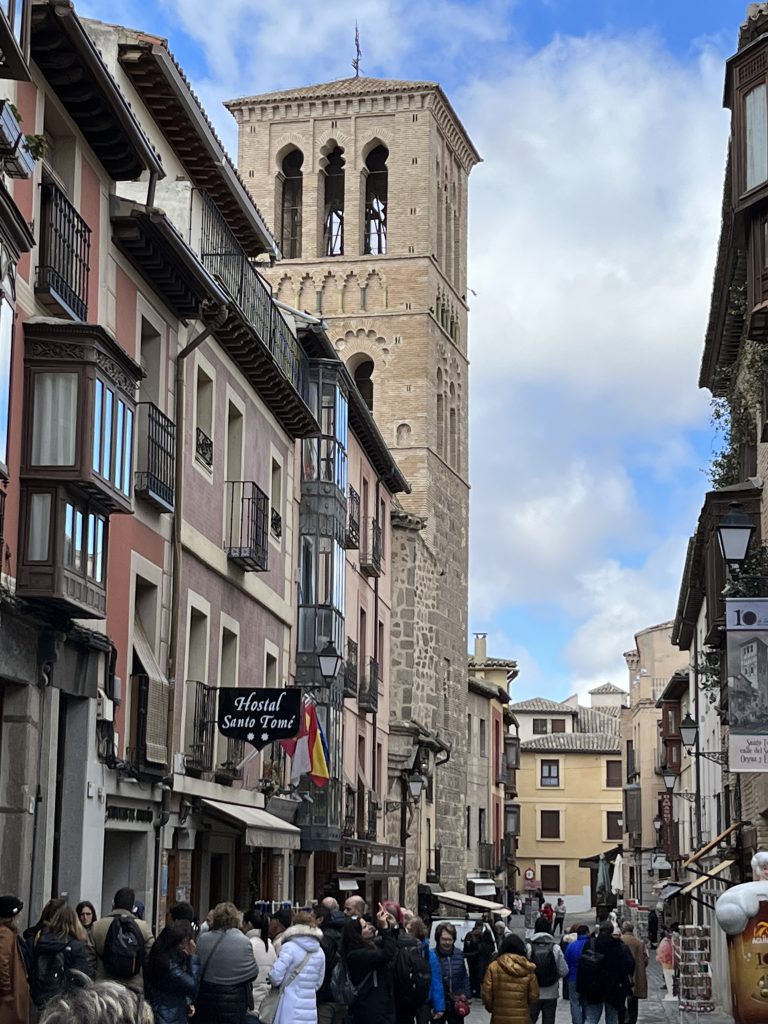

Right, Home Surrounded by Olive Orchard
While the Royal Palace and museums may demand attention because of their artistic achievements, the beautiful art and architecture of Toledo are practically unrivaled. The narrow, yet rustic corridors lined with shops and restaurants exude a distinct charm, almost like a bustling town surrounding a medieval castle. The architecture is unparalleled, infinitely more interesting than any city found in the U.S., the only point of reference I have. I would like to return, specifically to have more food and experience more that the city has to offer, especially during one of its religious festivals or bull fights. Without a doubt, Toledo demands multiple visits to absorb all the sights, tastes, and sounds it has in store.
